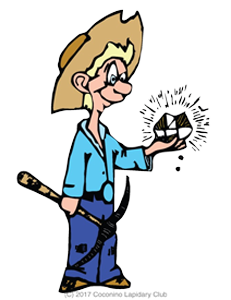
Today my main topic is the mineral Wulfenite which has a strong association with Arizona. Lead mines, in which Wulfenite has been found, are numerous, with some of them offering such beautiful examples of the mineral that they have become classic localities. Among these are the Rowley Mine and the Glove Mine. More photos of Wulfenite
Wulfenite, having lead in its composition, is found primarily in lead mines and is widely distributed among Arizona mines as shown on the map of occurences: Map
There are 137 of these mines, with distribution from North to South and East to West. An article by the former Curator of the Arizona Mining and Mineral Museum, Jan C. Rasmussen, identifies eight mines noted for the aesthetics of the Wulfenite specimens found in them, and describes the physical and historical geology of the region, as well as the geochemistry describing the mineral deposition. The author also includes photos of specimens from each mine in this downloadable pdf document. Arizona Wulfenite by Jan C. Rasmussen

The wide range of yellow to red colors is notable among Arizona specimens. However, for completeness sake, Wulfenite specimens come not only in shades of red, orange, and yellow – as this one in figure #2, from the Glove Mine – but they can also be made black by manganese inclusions, such as the one in figure #3. Other grey to black inclusions of such ore minerals as metal sulfides would have a similar effect.

The beautiful yellow to red colors of Wulfenite deserve mention of their origin. I will paraphrase the explanation in this post by Fred Haynes
Since lead molybdate is colorless or white: the color must arise from another metal with the same valence as lead. Trace amounts of vanadium, manganese, chromium, and titanium are the source the colors. These elements do this by absorbing the violet, blue, and green parts of the visible spectrum. Some of the crystal forms evidenced by Wulfenite range between tabular, through blocky, to highly elongated as shown by examples in the Atlas of Crystallographic Forms of Wulfenite and the vast gallery of photographs at its Mindat site, which I linked to at the beginning of this blog. Just click on the icons in the atlas to view these forms. Some of the basic forms evidenced are modified by beveled edges and corners which add to their interest.
On Building a Collection: In my first blog I stated that I would provide some insights on how to build a collection that would maximize your enjoyment. Rather than paraphrase their content I’ve provided links, below, to the websites which offer sound advice on subjects ranging from the aesthetics of a specimen through pragmatic How To’s, to how to build a collection on a budget. I hope these ideas serve you well in the process of building your collection
Desirable to mandatory specimen attributes: http://farlang.com/how-to-build-a-mineral-collection
Pragmatic advice: http://www.johnbetts-fineminerals.com/jhbnyc/articles/advice.htm
Pragmatic advice including building upon locality, one species, etc:
http://www.mcdougallminerals.com/blog/seven-keys-to-building-a-great-mineral-collection/
AND http://www.minerals.net/resource/Organizing_Mineral_Collection.aspx
Building a collection on a budget: http://www.treasuremountainmining.com/index.php?route=pavblog/blog&id=133
A short personal note: Shortly after I began collecting, I learned of a mineral dealer named Jack Filer who, with son Russell, dealt in mineral specimens and were located close to my home. Frequently, on a Saturday, with or without money in my pocket, I would go over to visit Jack. Even without purchasing anything, I was welcome to visit, ask questions, eagerly sop up information and hear their stories of mining and collecting, and so wonderfully allowed to hold and pore over specimens, as well as help Jack in curating his collection. All of this was an incredible privilege. I include these remarks not only to reminisce, but to also point out the importance and joys of having a mentor who knows a lot about minerals, communicates well, particularly in question-answer form, and who really cares about you and your education about minerals. Jack and Russell started me out in becoming the collector I remain today. I will always be grateful for them.
